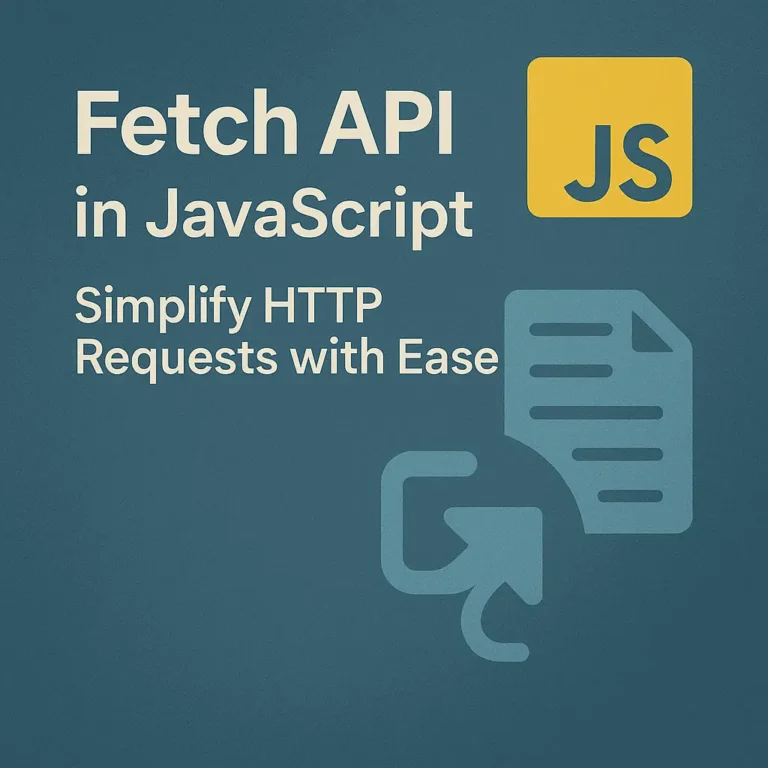What are Web APIs?
Web APIs, or Application Programming Interfaces, serve as intermediaries, enabling communication and interaction between different software applications over the internet. Specifically, in the context of JavaScript, Web APIs provide a set of functionalities and methods that allow developers to access various browser features and services.
JavaScript Web APIs are typically divided into different categories based on their functionalities:
Document Object Model (DOM) API:
The DOM API allows JavaScript to interact with the structure and content of HTML documents. Developers can manipulate elements, attributes, and styles dynamically, enabling the creation of dynamic and responsive web pages.
// Example: Changing the text content of an element
const element = document.getElementById('example');
element.textContent = 'Updated content';
Fetch API:
The Fetch API provides a modern interface for fetching resources (e.g., JSON data, HTML, images) asynchronously over the network. It offers a more flexible and powerful alternative to traditional XMLHttpRequest.
// Example: Fetching JSON data from a server
fetch('https://api.example.com/data')
.then(response => response.json())
.then(data => console.log(data))
.catch(error => console.error('Error fetching data:', error));
Web Storage API:
This API allows developers to store data locally in the user’s browser. It includes mechanisms such as localStorage and sessionStorage, which offer simple key-value storage solutions.
// Example: Storing data in localStorage
localStorage.setItem('username', 'exampleUser');
Canvas API:
The Canvas API provides a way to dynamically generate and manipulate graphics, allowing for the creation of interactive visualizations, games, and multimedia applications directly within the browser.
// Example: Drawing on a canvas
const canvas = document.getElementById('myCanvas');
const ctx = canvas.getContext('2d');
ctx.fillStyle = 'blue';
ctx.fillRect(10, 10, 100, 100);
Importance and Applications
The significance of JavaScript Web APIs in modern web development cannot be overstated. Here’s why they are indispensable:
Enhanced User Experience:
Web APIs enable developers to create rich, interactive user experiences that rival native applications. Through features like animation, real-time updates, and offline functionality, developers can deliver seamless and engaging web experiences.
Cross-Platform Compatibility:
JavaScript Web APIs are supported across all major web browsers, ensuring compatibility and consistency across different platforms and devices. This allows developers to reach a broader audience without worrying about compatibility issues.
Improved Performance:
By leveraging Web APIs for tasks such as data fetching and local storage, developers can optimize performance and reduce the need for server-side processing. This results in faster load times and smoother interactions for users.
Integration with Third-Party Services:
Many JavaScript Web APIs facilitate integration with third-party services and platforms, such as social media APIs, mapping APIs, and payment gateways. This enables developers to extend the functionality of their web applications and tap into a vast ecosystem of services.
Progressive Web Applications (PWAs):
JavaScript Web APIs play a crucial role in building Progressive Web Applications, which combine the best features of web and native applications. PWAs leverage service workers, web manifest files, and other Web APIs to deliver reliable, fast, and engaging experiences that work offline and on low-quality networks.
Conclusion
In summary, JavaScript Web APIs empower developers to create dynamic, feature-rich web applications that deliver exceptional user experiences across different platforms and devices. By mastering these APIs and understanding their capabilities, developers can unlock a world of possibilities in modern web development.
As technology continues to evolve, JavaScript Web APIs will remain at the forefront of innovation, driving the next generation of web experiences. Embracing and harnessing the power of these APIs is essential for staying competitive and pushing the boundaries of what is possible on the web.






